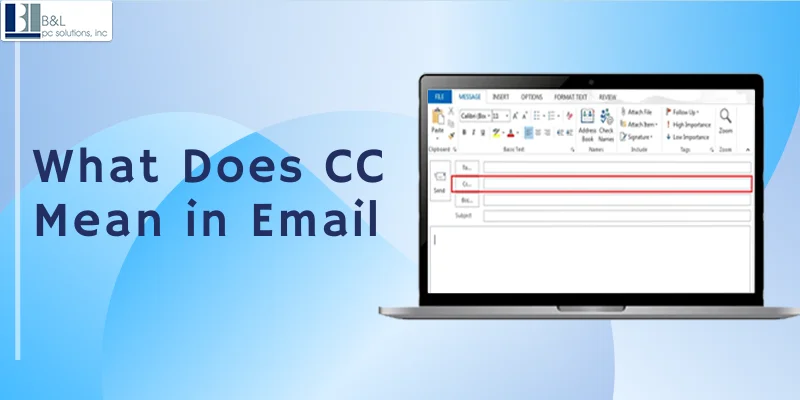
We are all aware of including more than one person in an email to keep them in the loop regarding every piece of information. In addition, email is known as the best formal communication channel for personal and professional purposes. Email makes it easier to communicate with colleagues, buddies, or customers. The structure remains the same for writing an email, but knowing the multiple elements is essential for clean and assertive communication.
One term that is regularly utilized in emails, in particular inside the context of sending emails to a couple of humans, is “To,” “CC,” and “BCC.” In this blog, we will talk about “CC”. But what does it surely mean? Let’s understand here:
What is CC in email?
CC is an acronym that stands for "Carbon Copy." It's a word that dates back to the days of typewriters when letters were copied on carbon paper. A copy of an email can be shared with someone other than the principal recipient in the modern email world by using the CC feature.
The people listed in the CC box will receive a copy of the email, just like the primary recipient, when you use CC in an email. However, the key distinction is that they're not the message's principal audience. Instead, they're being stored in the loop or made aware of the email’s content.
How Does CC Work?
When you are drafting an email, you have several fields wherein you can input recipients:
-
To: This is where you put the email addresses of the primary recipients, the primary human beings to whom you're sending the email.
-
CC: This is for those who need to be informed of the email but aren't the principal recipients. These people will see the email in their inbox, but they’re not anticipated to take any on-the-spot action.
-
BCC (Blind Carbon Copy): This is every other discipline for adding recipients, but unlike CC recipients, BCC recipients aren't visible to others. We’ll get into BCC in a piece.
Why Use CC?
Here are a few motives why you may use CC when sending an email:
Keeping Others Informed
When sending a critical email to a primary recipient, you should hold others in the loop who are continuously involved in the subject matter. For instance, you can email a challenge manager (the primary recipient) and CC a colleague operating on the same project. This guarantees the colleague receives the statistics they want but doesn’t require them to take instant movement.
Formal Communication
In organizations, it’s familiar to CC supervisors, managers, or departments on emails to ensure people know essential communications. For instance, you might email a client and CC your manager so they know the verbal exchange occurring.
Record-Keeping
Sometimes, you want to create a record that ensures people are knowledgeable or blanketed in crucial communication. CC ing relevant people lets you keep us concerned and creates an unmistakable trail of verbal exchange.
Related Blog: How to Recall an Email in Outlook: A Step-by-Step Guide
Who Should You CC in an Email?
It is important to be careful about who you put in the CC field, even if it is tempting to CC everyone who has a passing interest in the subject.
Relevance is Key
Ensure the people you are CCing want to understand the email or conversation. If they are now not directly involved or want to take no action, it is probably taken care not to CC them.
Avoid Overloading with CCs
Too many CC recipients can create confusion or useless clutter. People may also need to respond despite no longer being the primary recipient. Keep your CC listing brief and relevant.
Privacy Considerations
In a few instances, CCing someone might be inappropriate if their inclusion violates confidentiality or privacy. Be conscious while choosing who to CC.
When Not to Use CC?
While CC is a significant element, it’s important to recognize when it is no longer used. Here are some conditions wherein CC may not be appropriate:
Sensitive Information
If your email contains confidential information, avoid CCing individuals who don’t need to see it. You must ensure that only the relevant events have been admitted to personal or personal info.
Overuse of CC
As referred to earlier, overusing CC can clutter an inbox with unnecessary emails. You don’t need to harass recipients by CCing them on each email, mainly if the message is no longer relevant to them.
Too Many Recipients
If you’re emailing many people, consider using BCC to defend privacy and avoid overwhelming anybody with a list of email addresses.
Read More Blog: How to Add a Shared Mailbox in Microsoft 365 (Outlook Desktop App & OWA)
Final Thoughts
In the world of email, CC is a precious element for ensuring that the proper human beings are saved inside the loop without burdening them with the responsibility of appearing in the email. It allows for higher transparency and communication, particularly in organizational settings.
However, it’s essential to use CC thoughtfully. Don't CC people just because you want to; make sure they need the information and won't find it stressful. If you're worried about privacy or don't want to overload your receivers, utilize BCC wherever possible or contact B&L PC Solution for email encryptions .
You can communicate effectively and make sure that everyone who wants to know you knows it now that you know what CC in an email means and how to utilize it effectively!
Tags: How Does CC Work, What Does CC Mean in Email, When Not to Use CC, Who Should You CC in an Email, Why Use CC





